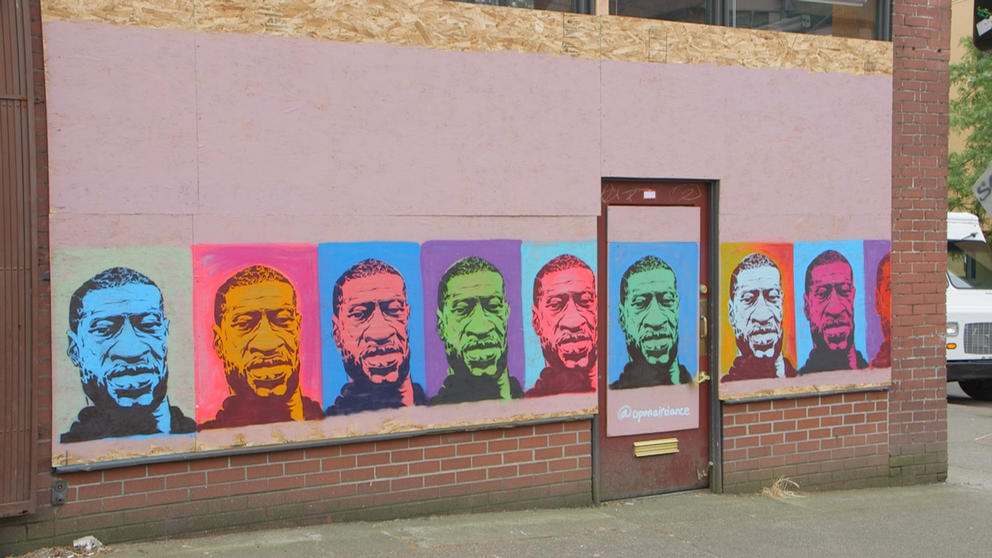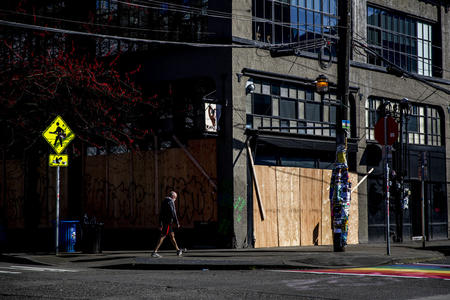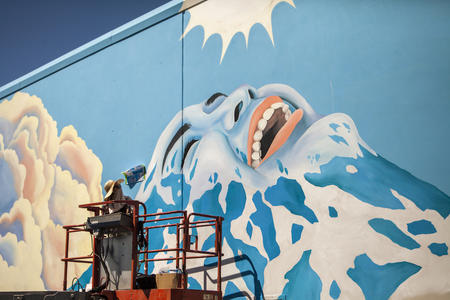“It's like an art gallery right on the streets of our city,” says Phil Bevis, publisher at Chatwin Books and owner of Pioneer Square bookstore Arundel Books. The store is currently operating with the door propped open, but the windows are still covered with plywood, painted by artist Amanda Bishop. “In my lifetime, this is the single most impactful example of how public art in a time of crisis can raise a community’s spirits,” Bevis says.
Though foot traffic in the neighborhood has dwindled, Bevis has been working overtime lately, staying late to finish the galleys for a new book he’s publishing: Viral Murals: Seattle Artists, Storefront Murals, and the Power of Art During Crisis, a 250-page, full-color tome featuring more than 140 murals created in the wake of local COVID-19 closures. Bevis hopes to start working on a follow-up book featuring Black Lives Matter protest murals as soon as Viral Murals rolls off the local presses.
Seattle has a worldwide reputation for its murals. Here's one of the reasons why.
That’s a quick turnaround for Chatwin Books, a small, local publishing house and press (co-founded by Bevis and book designer Annie Brulé) that’s accustomed to months of pre-printing prep. Bevis and Brulé cut production time in half in order to publish before too many murals come off the windows. “We’re not sure how long they will last,” Brulé says. “Some have already come down. They're disappearing.”
Bevis and Brulé are not the only ones racing against time. As local stores and restaurants get ready to reopen, art lovers, historians, businesses and museums are trying to answer a question trickier than it may seem: When the plywood comes down, where will the murals go?
Preservation-minded local institutions might seem like a logical answer. Seattle’s Museum of History and Industry (MOHAI), the Museum of Pop Culture (MoPOP) and the Washington State Historical Society all say they are hoping to acquire some of the plywood murals in an attempt to preserve a slice of history as it’s still unfolding. “Usually, people assume history museums want [only] old stuff,” says Clara Berg, MOHAI’s curator of collections. “What’s interesting about this moment: Everyone is thinking about collecting right now. People recognize that we’re living through historic times.”
Not just because of the pandemic: Why some Seattle businesses decided to board up
Meanwhile, local businesses and neighborhood associations are floating their own ideas for the murals, including a large-scale outdoor exhibition and auction for charity, a public art festival on the anniversary of the shutdown or donating murals (which are on usable plywood, after all) to builders of tiny houses. Some businesses say they’ll take the art indoors or return it to the artists; others plan to store the art in case a second coronavirus wave demands a future boarding up.
If they have enough space, that is. In the pursuit to preserve thousands upon thousands of square feet of plywood, storage capacity is proving a major issue. And even if an organization does have enough space, it needs to be the right temperature and humidity so the plywood doesn’t rot or mold.
Watch: Muralists reflect on the role of public art during pandemic isolation and social protests.
“It’s relatively easy for my team to handle pickup of boards as they come down,” says Seth Geiser of the Downtown Seattle Association, which coordinated many downtown murals and has already collected at least 10 boards from businesses that have reopened. “It’s a much bigger lift to find a secure, accessible storage location.”
Ownership is another issue. In some instances, it’s not clear who would give institutions the green light to acquire the murals or sell them for charity: the businesses? The artists and their sometimes unnamed collaborators? The neighborhood associations that commissioned them?
In the absence of official contracts (and in some cases, payment), some neighborhood organizations and others now find themselves working like COVID-19 contact tracers but in the name of art, reaching out to businesses and artists to figure out who owns the boards or has ideas about what should happen to them.
“Typically you would figure that out ahead of [time], but these murals went up quickly — which was great,” says Jessica Rubenacker, exhibition director of the Wing Luke Museum of the Asian Pacific American Experience, which is planning to acquire some of the murals that have gone up in the Chinatown-International District. “But now there are these bigger questions.”
Even thornier questions surround the art of the Capitol Hill Organized Protest (CHOP), which was cleared out by police last week. City workers and contractors took down large, plywood Black Power fists and green “Black Lives Matter” street signs from light poles and loaded them into city trucks. They disassembled a tall, monochrome portrait of Charleena Lyles, the pregnant mother killed by Seattle Police in 2017, and other plywood art that had surrounded the precinct. Earlier that week, self-declared “art leads” of CHOP had already loaded multiple sheets of painted plywood into a weatherproof container provided by the city.
Much of the CHOP art currently sits in city-owned storage facilities, including the Seattle Department of Transportation’s traffic signs and signals shop in SoDo. Seattle Parks and Recreation is holding on to the disassembled fragments of artist Jon Top’s tall, Black Power fist sculpture that was attached to the baseball backstop at Cal Anderson Park, while discussions take place over where Top wants it to go, the city says.
For now, much is still unclear. The city’s Office of Arts and Culture says it will photograph and catalog the art of CHOP and intends to be a steward of it — not an owner. Officials from various city departments are in talks with CHOP art leads, artists and others in the hopes of figuring out who made which piece and what they think should happen to it. That process is challenging: Many CHOP art pieces aren’t signed or tagged, and there’s no single representative for all the artists. While perhaps well-intentioned, outside input isn’t always welcomed by the protesters or artists themselves.
This complicated dynamic became clear this weekend, when Lawrence Pitre, an artist who leads the nonprofit Central Area Chamber of Commerce, took it upon himself to coat the large “Black Lives Matter” street painting on Pine Street with a clear sealant in hopes of preserving it — without consulting the artists who created it, the 16-member Vivid Matter Collective. The group was already in talks with the city about touching up the paint themselves in a way that wouldn’t seal in dirt.
For artist Barry Johnson, who painted the first “E” filled with brightly hued blobs, it’s emblematic of the confusion surrounding the fate of the large-scale painting. He says the collective had no idea the city had decided to preserve the artwork until the city’s Department of Transportation put traffic diverters around it.
“Initially, everyone was upset about that,” Johnson says, explaining that participants felt like the city prioritized the art over the underlying issues. “They keep this while people are getting arrested and other artworks are getting power-washed off.”
Still, the collective is dedicated to preserving the work: community support for preserving it is strong and the message behind the words, he says, is just too important. But to Johnson and other artists in the collective, the process raises questions about which art gets valued and why. Is their message saved because it’s a beautified, digestible version?
“Don’t memorialize the monument and miss the message,” co-muralist Aramis O. Hamer wrote on Instagram, noting that many seem to want to “protect the BLM, but forget these Black lives.”
Questions around what will and should happen to the CHOP and Black Lives Matter protest art come amid a worldwide reassessment of the curatorial and collecting power of museums, which have a long history of appropriating and stealing art from nonwhite artists.
Who decides what art is (and which BLM street paintings might get an artist detained)? What happens to art when you airlift it out of context? What should be preserved and, more importantly, by whom?
MOHAI’s Berg says the current conversation is about “moving away from that historic museum approach of ‘my museum needs to get the best stuff,’ ” and instead “thinking about what are the preservation goals of the whole community?” She says museums are looking at new models of collaboration with other institutions and organizations that maybe don’t fit the typical nonprofit model.
“Institutions are being asked to look at their policies and procedures,” says Stephanie Johnson-Toliver, president of the Black Heritage Society of Washington State. “There is controversy, discussion and honest concern around how institutions select and acquire art and artifacts.”
Johnson-Toliver is joining the discussion as part of an ad hoc group that convened in the wake of CHOP’s dismantling. Representatives from CHOP, the city of Seattle, MOHAI and the Black Heritage Society recently had a Zoom meeting — initiated by CHOP protester and UW museology graduate candidate Dawn Dailey — in order to start discussing what will happen to the art currently in storage. Not much has been decided yet, all say they will defer to the artists to make the call on where the art will go.
“Initially, when I heard that everything [from CHOP] was coming down, I too reacted in a way like: ‘Please let us take two or three of those panels and hang on to them and preserve them for future generations to help tell this story,’ ” says Johnson-Toliver. “But I had to then sit back and listen to the artists and hear what they had to say about how public this art was meant to be. It’s visual, it's emotional… They’re giving voice to the protests. It was a message that was meant to be shared.”
Kyana Wheeler, an anti-racism consultant who teaches “Museums and the Movement for Racial Justice” at the University of Washington, was also part of that first discussion. To Wheeler, the conundrum around the CHOP art represents a microcosm of larger discussions on the future of museums. That’s why she’s thinking of assigning a case study in class next year on what to do with the art of CHOP as a way to ask questions about art and protest, power and ownership.
“That’s the bigger picture,” she says. “How are we valuing some things over people? How are we valuing some folks over others? None of these things are separate from each other. We should be asking as many hard questions as possible.”
Get the latest in local arts and culture
This weekly newsletter brings arts news and cultural events straight to your inbox.











